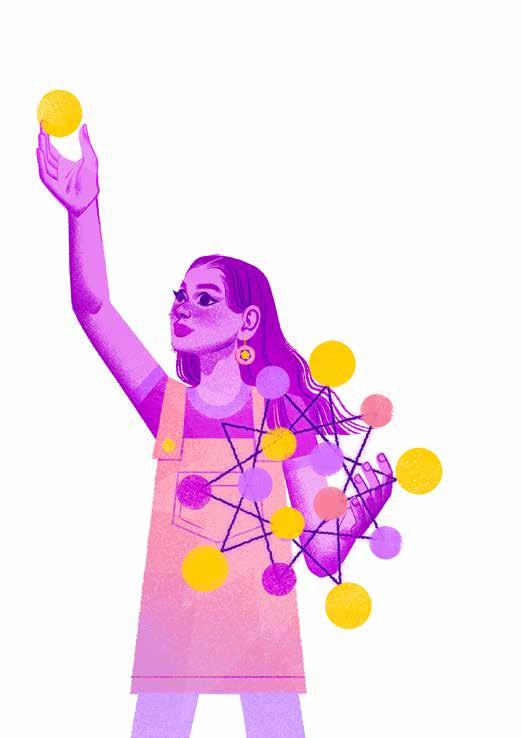
10 minute read
The Upcycled School
The Upcycled School
Reshaping education with passports and passion projects
Advertisement
By Nicole Miller
Illustration by Cristian Fowlie
How can schooling transform as a result of the upending of 2020? With the social unrest in the United States and Canada in response to anti-Black racism, increased concerns by marginalized groups and the highlighting of extreme inequities during a pandemic, we know that school can, and should, learn from these lessons and change. Returning to our old ways is always tempting, as change can be scary, and what was “normal” feels most comfortable for many of us. We need courageous leadership to look into communities and ask how we can do better. How can we upcycle schooling?
Upcycling, defined in environmentalism, is the process of creatively reusing something to create something better and of higher value than the original item. In education, we have a chance right now, unlike any time in recent history, to redefine what school looks like. We can look at things anew and build something that is more inclusive, more equitable and better reflects student and parent voice.
I have been a principal for seven years, an administrator for 10 and a teacher for many years before that. In my first principalship, I was fortunate to have a parent group that was truly interested in building a school that engaged our families and welcomed them back into a building where they felt historically unwelcome. Many had been students at the same school years before and were reluctant to come in and discuss their children’s progress. They simply didn’t trust the school. It was hard to get parents to attend school council meetings.
We started a number of community events, including a staff-funded breakfast club, a walking bus to school (we walked up to the buildings that fed into the school on Walk to School Wednesday and picked up the kids before school), a community garden and more. School council meetings were held off-site, closer to the homes of the parents. We worked hard to be creative about supporting student learning. By the fourth year, we had built an engaging environment and achievement on the standardized EQAO test had risen more than almost any other school in the board that year.
We learned how essential parent engagement and student voice are to educational improvement. It was powerful learning to see what happens when distributed leadership meets servant leadership. Having said that, one thing it did not do was shift the way school works for all kids and families.
The best example of my own failure in this goal was a situation with an Inuit family. The children were often arriving at school at 11:00 a.m. or later. They were behind in their reading and math skills so we were concerned that they were missing literacy each day. In speaking with the grandmother, she explained that school didn’t work that way where they grew up – kids stayed up late with the family and were able to sleep in and pop in to school when they could.

At the time, I had difficulty wrapping my head around the fact that our system failed to bend to accommodate these beautiful, happy, children and instead of shifting our literacy times or creatively organizing some afternoon learning for them, we continued to try and find “strategies” to get them to school on time.
The reality of 2020 has shown us that we can pivot to online learning if we need to, we can do both synchronous and asynchronous learning. We can do half-day in school and half-day at home learning. Kids can write their book reports in their pajamas at night. In short, we can do better and bend for the families we serve to engage all students in the way that is best for them. It is time to upcycle education.
Our goals for addressing anti-Black racism, inequitable and inaccessible situations for students with learning challenges and a destreaming of secondary courses will not be successful unless there is true systemic change and new ways for students to access curriculum and learning.
As a doctoral student at the Ontario Institute for Studies in Education (OISE), I have worked extensively on the idea of school culture as it relates to unionized environments. There is much written about the ways collective agreements impede change through the restrictions on a teacher’s day in terms of teaching minutes, preparation time and restrictions on the number of meetings that can be held in a month. In my experience, however, teachers are dedicated and caring individuals who are open to transforming the way school works for students. And we can do it by partnering with unions and working directly with teachers ready to lead the way.
There are many creative alternative schools that exist in Canada and around the world. None of the ideas are specifically unique, as they have been gleaned from a number of systems and research on good pedagogy. But why have we adhered to the same thing for so long? I have heard the expression “rearranging deck chairs on the Titanic” in reference to the ways we identify and implement band-aid solutions to larger systemic problems at school.
So, how do we challenge and change the system to include student voice and choice, collaboration, a move away from “subject specific learning” and have teachers as true facilitators and supporters of student learning? It is time for intent to meet practice.

The Passport School
The Passport School is a secondary example but could be translated to elementary. The idea is to take courses and divide them into modules that are chosen by the students and facilitated by staff proficient in these various areas. It is the creative timetabling of modules such that a student needs enough modules to earn the credit and can do it in a wide variety of ways. The beauty of this model is that over the course of a 4-year secondary school career, a student can access their learning at their own pace and through areas that are of interest to them. These modules will often offer cross-curricular course hours through project based learning and collaborative team teaching between various departments.
As an example, in Ontario a single course such as physical education is made up of 110–120 hours in adherence to the Education Act. For some students (let’s say me), physical education was, at times, an exercise in embarrassment and self-loathing. When I think back to this subject, I enjoyed some things – like swimming – but hated other things – like basketball and gymnastics. In retrospect, what is the purpose of physical education? Is it to teach us to endure humiliation? Of course not. It is, hopefully, to make us enjoy physical activity and continue healthy living into the future. Wouldn’t it be great if a reluctant participator could choose from options for their own passport?
• Volleyball Unit – 10 hours over 10 days (1 hour a day)
• Swimming Unit -–12 hours over 12 weeks (1 hour a week)
• Rock Climbing Unit – 12 hours over a weekend (trip-based, hours also provided for Environmental Education and Indigenous Landbased learning)
• Football 40 hours over a term – team based play, 2 hours twice a week for the term
• Nutrition Through Cooking – 2 hours twice a week for 3 weeks = 12 hours

Students construct their individual learning passport based on areas of interest to them, while also covering curricular content and big ideas.
In the above example, if a student participated in all of the modules, they would have 86/110 hours required for a course credit. Teachers who are passionate about outdoor education can do trips that provide hours for many courses. One camping trip could include science, geography, language (writing), lifeskills, history, survival and more.
And students who have no interest in sleeping in a tent on the ground would never, ever have to do that. Some may argue kids should be pushed out of their comfort zone, and I agree to a point. Building learning experiences that encourage struggle and creative responses, that activate skill building in teamwork, public speaking, project management, positive relationships and global competencies is essential.
Part of this learning will come from alleviating some anxiety and fear about school in general. I think we can agree that the “tear them down to build them up” method of education has left something to be desired.
This is not about having children avoid learning experiences, but there needs to be a way we can teach students about struggle and perseverance without having them feel isolated, embarrassed or disengaged from school.
This method of school organization also allows for many natural accommodations, making it more like a universal design for learning model. For example, students who have learning difficulties can focus on self-directed projects offered by teachers with expertise in reading, expressive writing, using their natural interest in a subject to motivate the gap-filling in areas of weakness. Students who find an entire term of a subject hard to manage can gain module hours in shorter module offerings.
For example, one teacher may offer a full term in a cross curricular course looking at the roles of chemical engineers, and the same teacher might also offer one-week modules about specific scientists and their contribution to their field. Students and teachers will do a better job of creating exciting, multi-faceted module offerings.

Teachers and Passion Projects
A wonderful superintendent, Rod Allen from Cowichan Valley in British Columbia, gave his teachers and administrators opportunities to offer something different for students through their own passions. He set aside and funded days for students to sign up for a variety of extra programs offered by teachers who wanted to do something different with their teaching and learning. The big winners were students, who could meet other students from all over the district and engage in something they found interesting, like visiting the clam gardens on the Gulf Islands, indigenous textiles and beading, emergency preparedness, rock climbing and so much more. Teachers were invigorated and students had fun. Why can’t we harness this passion all the time?
Teachers with interests in specific kinds of literature can offer book studies over the course of days or weeks that address all kinds of social justice issues. Data science and statistical mathematics can take hold in projects about Islamophobia or the ethics of horse racing. Teachers can take passion projects, link them to big ideas in curricula, and find joy with students who are interested in learning more.
This is just a brief overview of a much larger plan. School planning would ensure there were courses that addressed current events, difficult topics and history from new perspectives. Critical thinking would become a stated outcome. Rigor and excellence comes from students wanting to engage, to ask questions, to think deeply about important topics of today.
I have a deep passion for the patterns and beauty of mathematics, but sadly, I didn’t find it at school. If we use data science to teach social awareness, understanding the story that numbers tell, critical literacy and the danger of misrepresenting data, students could emerge from math class without ever saying, “But why do I need to know this?”
The reasons for a passport school and upcycling concept? It’s time that schools better engage the creative thinking and problem-solving skills our students will need as we move forward – addressing global competencies and digital citizenship. By having students drive engagement through an understanding of what they are interested in, we make the school fit the student, instead of the other way around.
Nicole Miller is a principal with the Toronto DSB and a doctoral student at OISE in the Education, Leadership and Policy Program.
Email: nicole.miller@tdsb.on.ca







